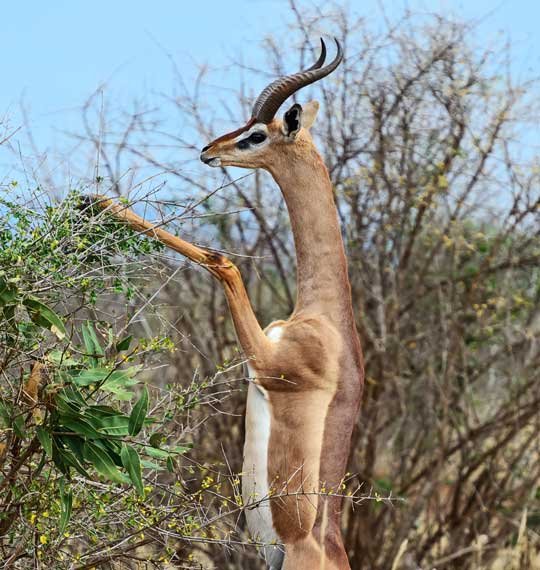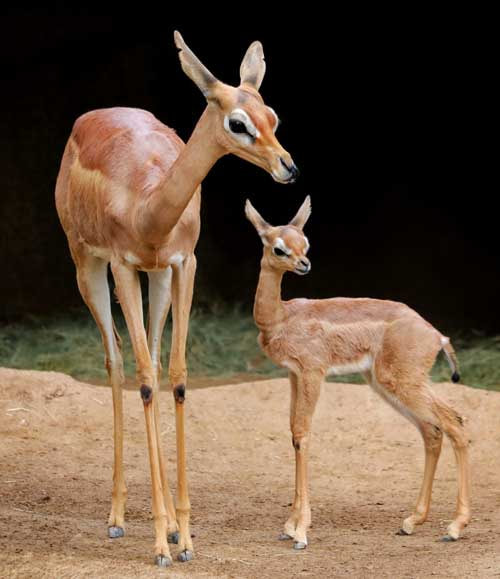|
I recently saw a photo of a gerenuk, and I thought, What the hootenanny is that thing?! It looks like an antelope or gazelle, but with a really small head, long neck, long legs, and the ability to stand upright like a human. I love discovering fascinating creatures I previously knew nothing about, so I did a bit of research. Behold, the magnificent gerenuk: What the heck is a Gerenuk? First of all, the name gerenuk means “giraffe-necked” in Somali. In fact, this creature is often called the giraffe gazelle (a gazelle is a slender type of antelope). Gerenuk antelopes are relatively small, about 3 feet (0.91 m) tall while standing on all four feet, and weighing between 62 to 115 pounds (28 to 52 kg). They live in the arid areas near the Horn of Africa (on the east side of Africa). The gerenuk is one of the most desert-adapted antelopes, surviving for long periods of time without water. Amazing Facts about Gerenuk Perhaps the most striking thing about these gerenuk antelopes is that they are built for reaching high to eat the softer leaves that are far above the ground. The neck is extremely long, topped by an almost comically-small head. Why such a small head? With this animal, it's all about reaching high and nibbling on soft, yummy leaves. None of that grazing on the ground business! If you want to hold something up high, it's easier if the object is smaller and lighter, right? Hence the long, thin neck and the tiny head. And the gerenuk's snout is tapered into a small, pointed mouth—ideal for nibbling on tiny leaves that are located between nasty thorns. This antelope exemplifies elegance and grace, don't you think? Standing straight up like that requires strong hind legs, and you can certainly see the legs' strength in the first photo above. In addition, the gerenuk has wedge-shaped hooves and specially-adapted vertebrae to help it stand erect. They are able to reach tender leaves, flowers, and fruits that many other animals can't. Because these choice foods contain a reasonable amount moisture, gerenuks rarely or never have to drink water. Check out this video about gerenuks. Gerenuks are what we call sexually dimorphic. That means the males and females look significantly different and are easy to distinguish. The males have horns and thicker necks, whereas the females never have horns, and their necks are amazingly slender. Here's a male gerenuk: Gerenuks are not as social as most other antelopes. They are often observed living alone, or in herds of only two to six individuals. Gerenuks can mate throughout the year, and when a male is in the mood, he becomes much less antisocial. He will seek out a suitable female, then stand in a sideways pose, showing off his horns. If the female indicates she is amply impressed, the male will "mark" her as his by rubbing a secretion from glands near his eyes onto her thighs. Once he has marked her, he will guard her from other males, following her around until she is ready to mate. How does the male know the female is ready to mate? By sampling her urine. This is known as the lip curl test. When the female is ready to mate, the chemistry of her urine will change, and it will pass the male's lip curl test. After a gestation period of six to seven months, females typically give birth to a single young. The mothers clean up their babies immediately, consuming the afterbirth to eliminate traces that might attract predators. Baby gerenuks are up and walking around only minutes after birth. So, the Gerenuk deserves a place in the B.A.H.O.F. (Bragworthy Animal Hall of Fame). FUN FACT: The word brag can actually be used as a noun, a verb, or an adjective. The noun form means "a pompous or boastful statement." The verb means "to talk boastfully." The adjective means "first-rate" (as in, "Stan's novels are not only brag, they are the braggest"). The verb form of brag originated in the late 1300s and meant "to make a loud sound" or "to talk boastfully." It's unclear when the adjective bragworthy originated, but there is no doubt that it means "worth bragging about." So, bragworthy is another way to say awesome! Photo Credits:
Gerenuk #1 - standing on hind legs - DepositPhotos Gerenuk #2 - head and neck - DepositPhotos Gerenuk #3 - male standing on hind legs - DepositPhotos Gerenuk female with young - ZooGirlSD via ZooChat
1 Comment
|
Stan's Cogitations
Everyone needs a creative outlet. That's why I write. Archives
July 2024
|





 RSS Feed
RSS Feed